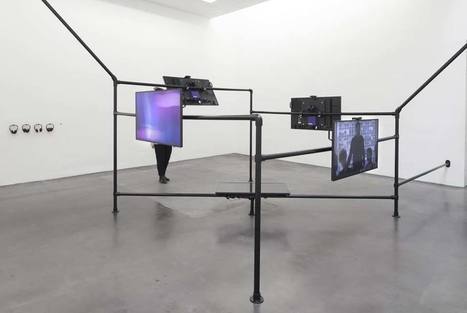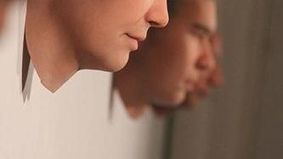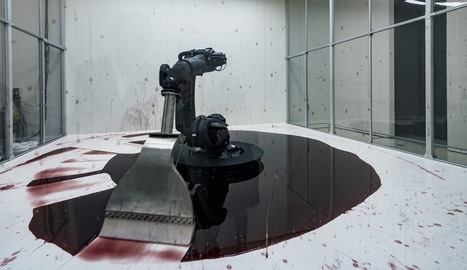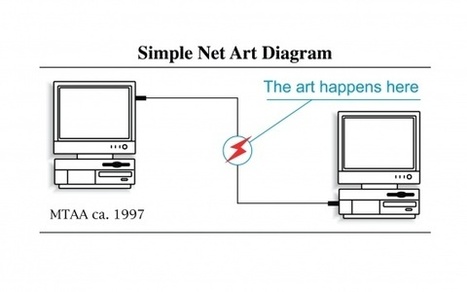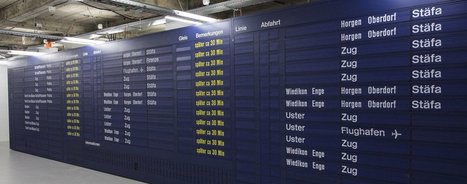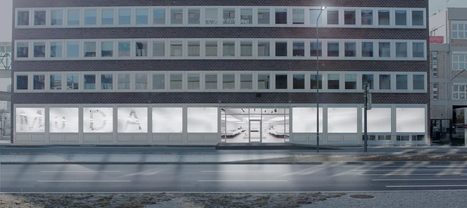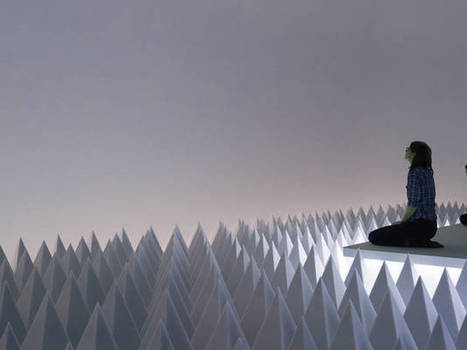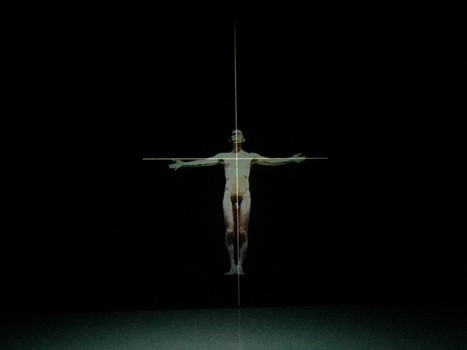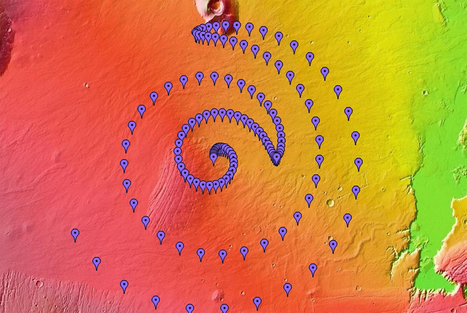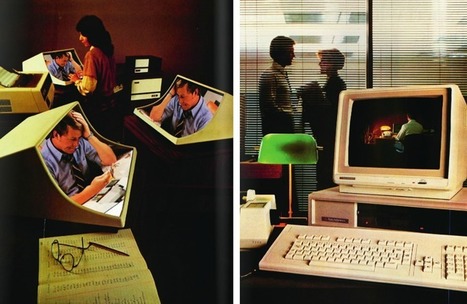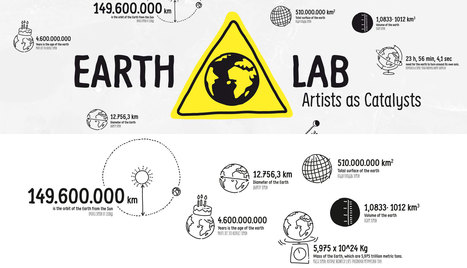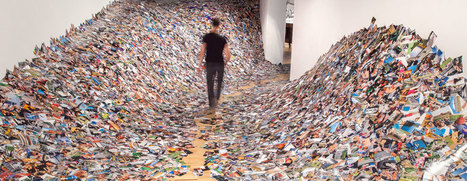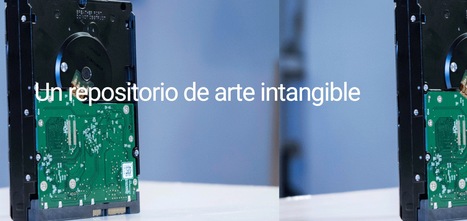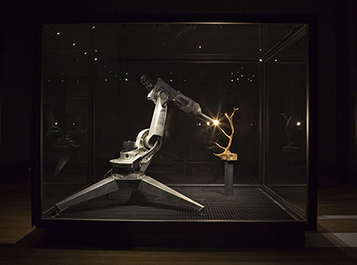 Your new post is loading...
 Your new post is loading...
Hello World!, is a survey of contemporary art focusing on the global digital revolution and its impact on our culture and economy, as well as human identity and behaviour. The exhibition in Kiasma, Museum of Contemporary Art, Helsinki brings together 35 artists from 13 countries representing three generations, from the ‘60s to the ‘80s. The ARS17+ Online Art website at arsplus.fi showcases a selection of new net art as part of the ARS17 exhibition at Kiasma.
Many of the artists featured in the exhibition are post-internet millennials, who are digital natives more or less from the moment they are born. For them, the physical and virtual worlds are inseparable components of the same merged reality. In their world, digital technology is not an end itself, but a tool for creating, sharing and experiencing.
Découvrez l'exposition "Mutations-Créations / Imprimer le monde" du 15 mars au 19 juin 2017 au Centre Pompidou à Paris Les technologies numériques ont bouleversé la conception et la fabrication des objets, transformant la pratique des architectes, des designers, des artistes. Quel est le statut de l’auteur à l’ère de la production d’objets « non standards », à la fois uniques et produits industriellement ? Quel est le statut de cet objet « imprimé » en 3D, tout à la fois objet du quotidien, objet technologique, œuvre d’art, objet de design, prototype d’architecture ? Comment expliquer sa généralisation à l’ère du numérique à tous les domaines de production ? Qualifiée de « technologie disruptive », l’impression 3D se diffuse depuis une quinzaine d’années à une large échelle à travers les plates-formes de logiciels « open source » et se développe dans l’industrie, de l’aéronautique aux biotechnologies. ... Commissaire : Mnam/Cci, Marie-Ange Brayer, Olivier Zeitoun
An enormous robotic arm, brandishing a giant squeegee, is poised over a pool of dark liquid which ceaselessly oozes outwards. With quick, smooth, aggressive movements, the machine performs a calculated dance, pivoting and dragging its squeegee across the surface in a perpetual labor of wiping the liquid back to the center. Can’t Help Myself, presented in the new exhibition Tales of Our Time, is an imposing installation by artists Sun Yuan and Peng Yu which holds the title as the Guggenheim’s first robotic artwork.
But robotic art is nothing new—so why did the museum wait until now to acquire a piece?
Sound ∆ ƒields (S∆ƒ) est une œuvre technologique sonore interactive.
Équipés d’un casque et d’un terminal, les spectateurs voyagent dans une cartographie sonore qui résonne avec les œuvres du musée.
http://sounddelta.leclairobscur.net
On October 27, Rhizome will launch a major new initiative, Net Art Anthology, with a presentation and panel discussion bringing together a group of artists who championed distinct and often conflicting approaches to net art practice in the mid to late 1990s.
Funded by a grant from the Carl & Marilynn Thoma Art Foundation, Net Art Anthology is Rhizome’s ambitious project to retell the history of a field of artistic practice in which even the most influential works often fade into obscurity as a result of technological obsolescence. It will restage a diverse selection of one hundred works from net art history, one per week, over the course of the next two years. The first phase of the Anthology will focus on works created before 1999, and launches on the day of the event with A Cyberfeminist Manifesto for the 21st Century (1991) by VNS Matrix...
Le pass, en association avec la fabrique de théâtre, cherche des projets d'artistes numériques pour la waouh zone...
En mars 2017, le Pass inaugure un nouvel espace d'exposition, la Waouh Zone, implanté au cœur de ses bâtiments historiques.
Cet espace, dédié aux cultures numériques, explorera les limites Arts/sciences/technologies en présentant une exposition de travaux artistiques réunis autour d'une thématique centrale, celle de la relation homme/machines. Pour mener à bien cette exposition, le Pass s'associe à la Fabrique de Théâtre et lance le présent appel à participation à destination des artistes numériques belges et européens dont les orientations artistiques et thématiques entrent en étroite ligne avec le projet.
Le choix des propositions se fera par l'intermédiaire d'un comité de sélection composé d'experts et constitué spécifiquement pour l'occasion. Date limite d'introduction des propositions : 05/09/2016 à 14h
Date de communication de l'avis de sélection : 23/09/2016
Le Pass, c'est un musée original qui invite à comprendre les sciences et les technologies en s’amusant.
Le Conseil des arts et des lettres du Québec (CALQ) est fier de s'associer au Musée de la civilisation à Québec (MCQ) afin de permettre la création in situ d'oeuvres numériques dans le cadre des résidences d'artistes Interface.
Ces résidences permettront l'expérimentation et la création en direct à partir des collections numérisées du MCQ afin de jeter un regard contemporain sur ces collections. Au carrefour des nouvelles technologies et de la participation citoyenne, l'oeuvre prendra forme dans le studio-laboratoire Interface, espace d'une superficie de 85 mètres carrés.
Date limite d'inscription: 20 mai 2016
e 13 février s’ouvre à Zurich le MuDA, première institution entièrement dédiée aux œuvres numériques. Visite avec ses deux fondateurs, passionnés de cet art que des algorithmes font vivre Caroline Hirt et Christian Etter ne sont ni historiens de l’art, ni forcément rompus à la conservation d’œuvres du patrimoine. Elle est ethnologue et travaille depuis une dizaine d’années sur la relation interactive entre l’homme et la machine, lui est graphiste et patron d’une petite entreprise de développement de projets de design multimédia. Ensemble, ils décident il y a quatre ans de remplir un vide muséographique. «Nous sommes tous les deux passionnées d’œuvres interactives et digitales. Il se trouve qu’aucun musée n’existait qui soit intégralement dédié à ce domaine», explique Caroline Hirt, Vaudoise née à Hongkong qui vit désormais entre Genève et Zurich. ...
The Residency invites creatives working across media, fields, disciplines, and administrations to create projects that activate Elsewhere. Residents live and work within the museum for 2-4 weeks creating site-specific, responsive work that explores the museum environment, surplus inventories, cultural histories, social systems, neighborhood communities, and past artworks.
Opening its doors in 2016, the Museum of Digital Art will be Europe's first physical and virtual museum dedicated to digital arts — an open space connecting creativity and technology.
Located in Zurich, Switzerland — a hot spot for science, technology and art — the MuDA will occupy the 400 m² ground floor of the Herdern Hochhaus, one of Switzerland's first high-rise building, a historically protected landmark.
The Museum of Digital Art is a project of the Digital Arts Association (DAA), a non-profit organisation domiciled in Zurich. The DAA was founded to promote digital arts and support its creators and community in the belief in computer code's potential and importance as an expressive artistic tool.
Objectives 1 — Inspire and engage a broad audience with digital art. 2 — Create public and neutral platforms to discuss the interactions between data, algorithms and society. 3 — Promote code-based technology, science and engineering to young people, especially women and girls. 4 — Establish and support regional, national and international collaborations in digital arts. 5 — Operate in a lean and sustainable way, without relying on unreasonable amounts of private or public money.
Internet est d’abord, et c’est historiquement sa vocation première, un espace documentaire, dans lequel sont associés des textes, des images et des sons, à l’intérieur d’un même site ou entre plusieurs sites distincts, selon une organisation particulière appelée hypertextuelle. Parmi les innombrables pages consultables sur Internet, les musées proposent depuis une dizaine d’années environ une présentation de leurs collections.
Le Conseil International des Musées (ICOM) a créé il y a trois ans un nom de domaine en .museum qui fait office de label pour les musées, et qui accueille actuellement 724 membres Cependant, un recensement approximatif des sites Internet de musées dans le monde, tous musées confondus, réalisé à partir d’un fichier établi par la Direction des Musées de France – et comportant aussi des organismes en rapport avec les musées : associations, bases de données, etc. – dénombre 1 690 sites.
Rapporté aux seuls musées recensés en France en 2001 soit 1 124, ce chiffre paraît bien en deçà de la réalité. Confronté, d’autre part, aux statistiques de fréquentation de ces sites (le Musée du Louvre annonce, pour l’année 2003, 6 millions de visites de son site Internet), on mesure, qu’on le déplore ou non, l’importance acquise par la consultation des sites de musées au cours de ces dernières années, favorisée par l’équipement accéléré du public et par le développement des réseaux numériques à haut débit.
...
OpenGLAM alerted me via Twitter that the entire digital collection of the Tate is available on GitHub. I haven’t heard of any other institution who makes their collection available through this platform. It does kind of give a lot away, but then again, that’s the whole point of open data. Why not Linked Data, asks a fellow Tweeter and Tate’s web architect Rich Barrett-Small justifies their move to GitHub with it being the most time- and cost-effective solution to get the data out there – for now.
Yes, SPARQL endpoints are the weapon of choice these days, but what’s wrong with using GitHub? It’s an incredibly versatile platform by far not limited to programmers, but equally useful for thesis writing or democracy.
Exposer l'Histoire d'Internet, ses usages, ses évolutions, ses philosophies: c'est la volonté des deux graphistes allemands Paul et Paulina Rascheja. Déçus de ne trouver que des musées virtuels consacrés au média, ils ont choisi d'ouvrir leur Musée de l'Internet, sans but lucratif. Et c'est un peu osé. Comment faire tenir, expliquer un monde libre, dans un espace physique? ...
|
Last year, the Solomon R. Guggenheim Museum captured the public’s attention with a working, solid gold toilet installed in one of its restrooms. This year, they're are going for something a little more subtle: A “desert” that’s acoustically soundproofed to prevent anything but the lowest of ambient sounds. PSAD Synthetic Desert III, as the installation is formally titled, is the creation of West Coast artist Doug Wheeler, who originally conceived the idea nearly 50 years ago. Working in collaboration with the museum, Wheeler is finally realizing the project after all this time.
Six months ago, I wrote some thoughts on the paradigm shift in how museums think about the balance between preserving an artwork and sharing it with the public. My conclusion was this: time-based media art installations do not truly exist until they are installed and, thus, these works must be exhibited — or “exercised” — with a certain degree of regularity. This is a concept first championed in the conservation field over a decade ago, by Pip Laurenson of Tate. Lovers, by Japanese media artist Teiji Furuhashi(1960–1995), is an excellent example of this. What follows is the story of how our team rescued this important example of early-1990s Japanese media art from a crumbling foundation of obsolete technologies (MS-DOS and LaserDisc, for starters) and ensured that it will live on so that generations long into the future are able to discover and enjoy it. In museums, where the work of the conservator is often dictated by what is scheduled for exhibition, it is unusual to have the opportunity to conduct in-depth research or conservation treatments on collection works that are not slated to appear in the galleries. There is, however, a rich tradition at The Museum of Modern Art of offsetting this trend through collaborations with academics and researchers. Through this, we are often able to build small-scale research projects that give students incredible real-world experience — and afford museum conservators the sort of research we wish we had more time for...
The Stedelijk Museum Amsterdam and MOTI in Breda are jointly acquiring 17 top digital works by contemporary artists in the Netherlands and abroad who are among the pioneers of digital art. This collaboration is spurred by MOTI’s change of course: it is due to reopen in the course of 2017 as the Stedelijk Museum Breda, where the legacy of the city of Breda will have a more prominent role.
In the short space of time that it existed, and under the management of Mieke Gerritzen, MOTI – founded in 2011 – has managed to build a remarkable collection of digital works by leading artists. The joint acquisition with the Stedelijk Museum Amsterdam means investing in a national collection in the field of digital art. This merging of curatorial vision transcends local museum policy. The course taken by MOTI in the collection of digital art coheres perfectly with the policy of the Stedelijk Museum Amsterdam, which is always geared to new forms of art with a particular interest in the cross-over between graphic design and visual arts.
L'espace virtuel du Jeu de Paume ouvre ses portes à une série d'expositions dématérialisées, coordonnées par l'artiste curateur Nicolas Maigret. Intitulé Futurs Non-Conformes, ce programme mêle art, ethnographie, critique et spéculation à travers 3 cycles (passé, présent, futur). Une occasion pour interroger son curateur autour des thèmes de l'anticipation, de la propagande de l'innovation et de l’archéologie des médias. Nicolas Maigret, Futurs Non-Conformes correspond à une forme que l’on peut appeler le « musée virtuel », pouvez-vous nous présenter ce concept ? Nicolas Maigret : Futurs Non-Conformes est une exposition en ligne, rassemblant une série de liens contextualisés autour de pratiques artistiques et techno-critiques. J’ai proposé que l’on articule ce programme autour de trois cycles, avec différents points de vue et différentes approches, qui chacune viennent décoder, décrypter et révéler les enjeux propres à différentes technologies, tout en développant une forte dimension critique. Nous avons donc écrit les présentations de chacun des projets avec les artistes, pour ensuite offrir un accès direct,via des liens hypertextes, aux expositions en ligne qui peuvent être aussi bien des collections d’objets (photos), que des éditions de magazines ou d’articles, des documentaires, etc...
The 2016 IK Prize, in partnership with Microsoft, challenged digital creatives to use a form of artificial intelligence to allow the public to explore, investigate or ‘understand’ British art in the Tate collection in new ways. An expert panel of judges selected a shortlisted four ideas in response to a brief on artificial intelligence. They included a proposal to give artworks the power to daydream, an intelligent machine comparing artworks with the never-ending stream of images from across the internet, an A.I. artist-in-residence learning to create art, and an experiment to see if a machine can learn to describe artworks as well as humans.
The Polytechnic Museum in Moscow and Ars Electronica Linz invite visitors to partake of a stimulating encounter with important issues having to do with our planet. Visitors become researchers in EARTH LAB, a fascinating mix of exhibits, participative infographics and a discursive ancillary program. The artworks are designed to stimulate creative processes and encourage people to look at the Earth from a very different perspective for a change. But the site of this rethinking process isn’t a museum or some other established institution; it’s the basement of the mothballed Red October chocolate factory in the heart of Moscow.
The amount of data that the world generates on a daily basis - from emails, selfies, Google searches and online purchases - is almost astronomically vast. How do we begin to understand the stories being told by the data revolution, when there is so much data already and more being created every second?
Experience data in a whole new light at ArtScience Museum's upcoming Big Bang Data exhibition. Through a series of thought-provoking data visualisation artworks, you'll gain new perspectives on the issues surrounding the rapid datafication of our world, and discover the ways in which our ever-expanding digital footprint is radically transforming our lives, our decisions, and the future of society itself.
Find out more about Big Bang Data by downloading the press release here.
From Frodo to Skynet – the new Malware Museum shows how viruses reflect our culture and our fears.
Computer viruses now have their own museum. The recently opened online Malware Museum exhibits samples of early viruses that often include amusing graphics or popular culture references. But the significance of viruses goes beyond funny curiosities from the 1980s and 1990s.
HarddiskMuseum seeks to transform the idea of a museum to an object of art, with an interactive system and a collective work, in which each participant and actor belonging to said frame work of art remains about the proposal, since the hard drive not understand content only available to people their memory, which can be filled with good and bad ideas.
The product of an ambitious partnership with the Musée des arts et metiers, the exhibition Eppur si muove (And yet it turns) focuses on the many links that exist between the fields of the visual arts and technology, as well as the decisive influence that the history of the sciences and technology has exercised on contemporary artists.
Filling all the Mudam Luxembourg’s exhibitions spaces, and in a spirit of dialogue, it brings together some seventy pieces dating from between the eighteenth century and the present day from the collections of the prestigious museum in Paris and about a hundred works by artists who through the questions that they engage with, the experiences they offer, and the manner of production and collaboration they employ embrace the themes that have run through the domains of technology and science for several centuries. ...
'Surround Audience' – the third New Museum Triennial, curated by Lauren Cornell and Ryan Trecartin – opened at the New Museum, New York, in February 2015. Dan Fox reports on the highlights of the exhibition. The Triennial’s predictive, rather than retrospective, model embodies the institution’s thirty-seven-year commitment to exploring the future of culture through the art of today. This third iteration of the Triennial is titled “Surround Audience” and is co-curated by New Museum Curator Lauren Cornell and artist Ryan Trecartin.
“Surround Audience” explores the effects of an increasingly connected world both on our sense of self and identity as well as on art’s form and larger social role. The exhibition looks at our immediate present, a time when culture has become more porous and encompassing and new considerations about art’s role and potential are surfacing. Artists are responding to these evolving conditions in a number of ways, from calculated appropriations to critical interrogations to surreal or poetic statements. ...
http://www.newmuseum.org
Dear visitors of JavaMuseum, the makers of JavaMuseum decided in 2010 to prove, whether the museum should be continued as a living organism or better become an historical monument of digital and virtual art. Even if “netart” will never be “dead” as one possible artistic expression by dealing with technologies used in Internet, also because technology changes and develops further on and in this way also its artistic use, the Internet was never explored substantially as a medium in art, and this has many reasons. While the real high time of “netart” was already in 2004, there was actually no real artistic further development, although technology had an enormous speed of development since then. This does not mean, that artists would not use the Internet and create Internet based art applications, but the artistic development is far behind the technological speed, and in a certain way, like fashion “netart” is continously repeating itself. JavaMuseum saw itis goal in being a promotor and encourage artists
by giving them the chance to receive the audience of the World Wide Web. But art needs to be created by the artists themselves, and this obviously came to its limits. This again does not mean, that tomorrow, next year or in ten years, Internet based art would’t get probably a real re-vival sometimes, but currently there lie no perspectives in maintaining JavaMuseum active. JavaMuseum was since its foundation in 2000, not only a virtual museum for virtual art, and one of a few of its kind, but it was simultaneously always also a piece of Internet based art itself created by Agricola de Cologne. And this piece of art is now officially completed in its incomplete way, typically for a context without beginning and end. By deciding for an in-active status, JavaMuseum will become from 1 January 2013 on an historical monument aimed to keep vivid not only JavaMuseum as a virtual museum of virtual art, and honour the art works and artists active in this field, but basically also the idea and ideal of the artistic self-determination and the creation of an activating, alternative type art working outside of the usual market strategies in contemporary art. In this way, JavaMuseum will be also the museum of lost, but not forgotten ideals.
|





 Your new post is loading...
Your new post is loading...
